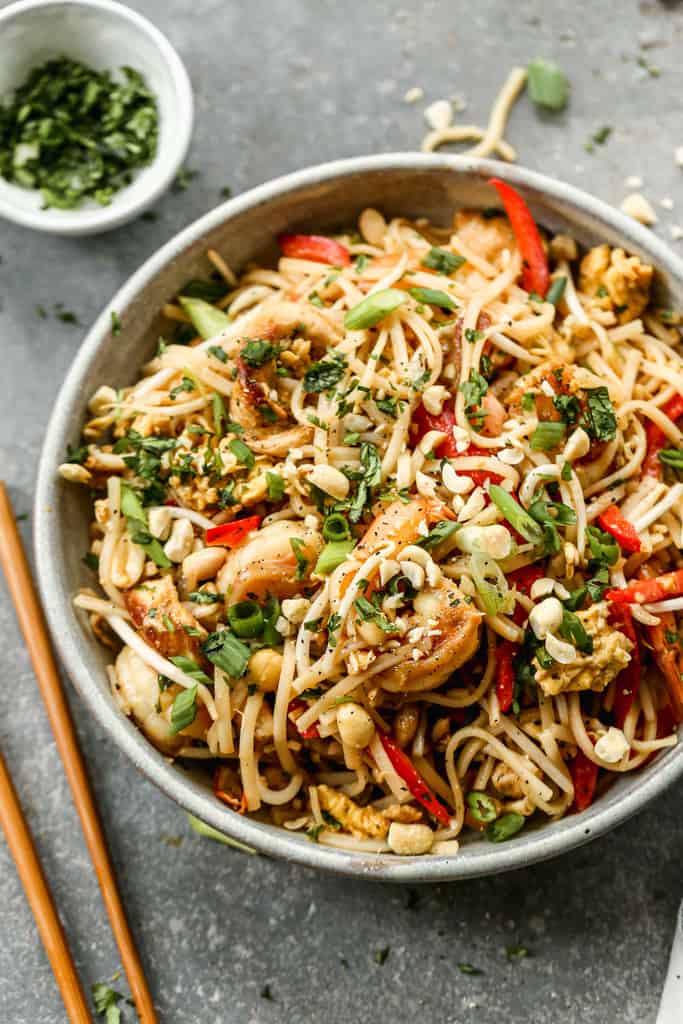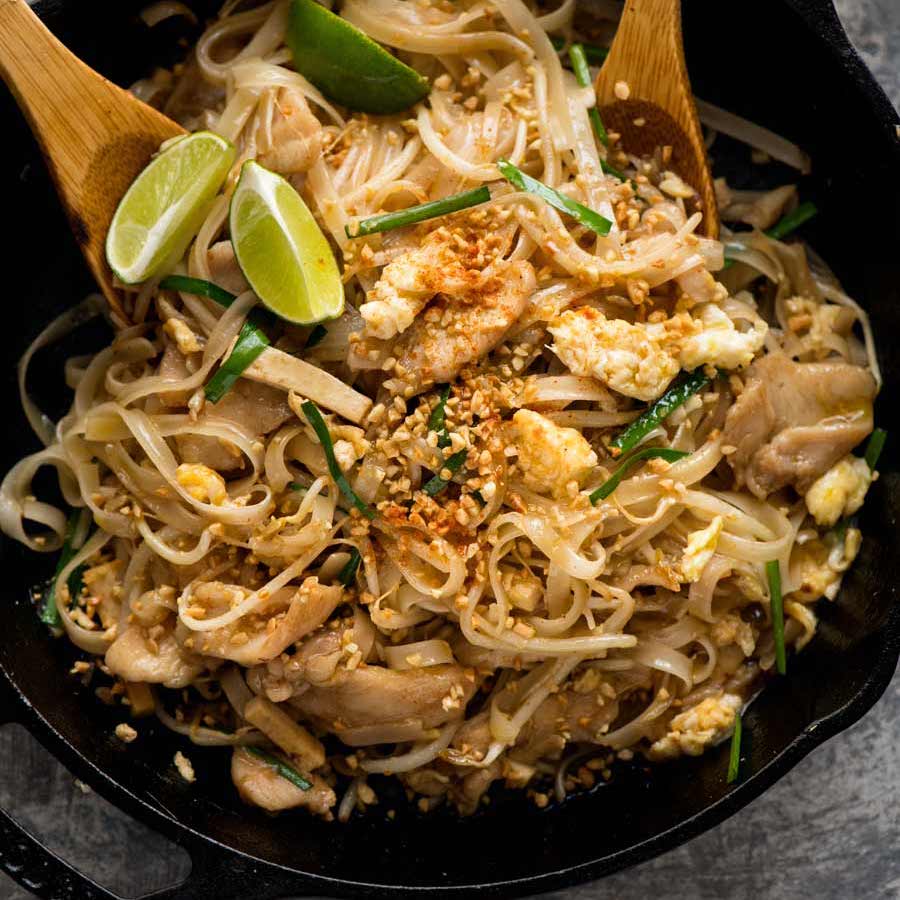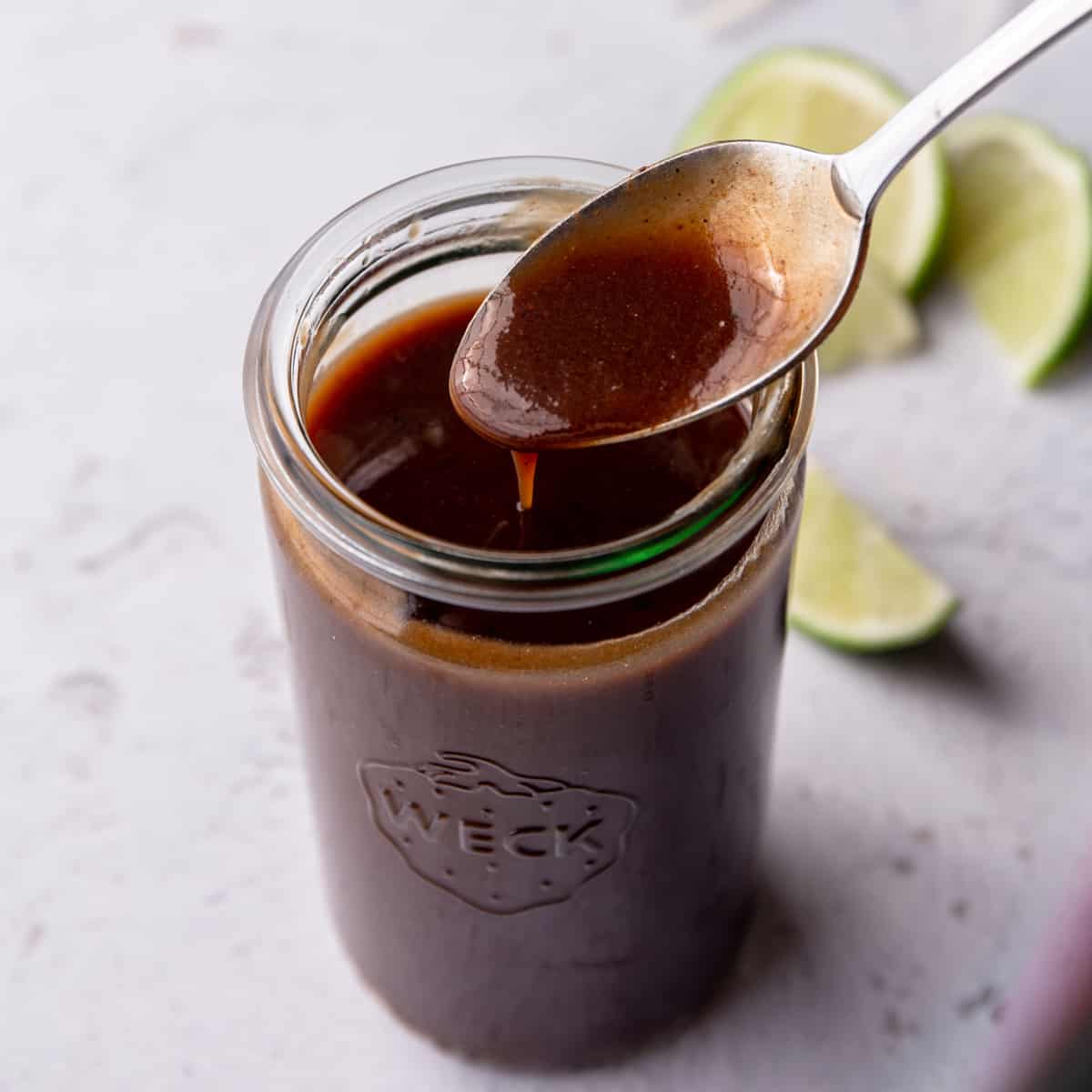Pad thai made from scratch isnt exactly a quick meal—there are a LOT of ingredients to prep. But how do restaurants get your freshly-made pad thai done in 5 minutes? Good news: theyre not doing anything you cant do at home. But the most important thing they do is to have the sauce made in bulk, in advance.
Once youve got the sauce made, and if you want to be even MORE prepared, there are a few other simple things you can do in advance so that, comes cooking time, you can literally get pad thai on the table in minutes. Watch the video to see me cook pad thai in less than 5 minutes in real time!
An authentic pad thai sauce is actually very simple. There are technically only 3 ingredients: the sweet, the salty and the sour. But because we want this to be a time-saver, Ive also add the shallots and the garlic into the sauce so we dont have to chop and sauté them on the day.
:max_bytes(150000):strip_icc()/pad-thai-sauce-recipe-3217195-hero-01-1fd957dbdaf344dc9d07233dc6b79fcd.jpg)
Homemade Pad Thai Sauce

Homemade pad thai sauce is miles better than anything you can buy, and with none of the additives. Using only a few simple ingredients, you’ll have this ready to go for a quick weeknight pad thai! This recipe is gluten-free, also check out my vegan pad thai recipe.
Prep: 5min
Yield: 8
Ingredients:
- 2 Tbsp oil
- 1.75 oz chopped garlic (about 1 head)
- 4 oz chopped shallot (about 1 cup)
- 4.9 oz palm sugar (roughly chopped)
- ½ cup fish sauce
- ¾ – 1 cup tamarind paste (see note)
- chili flakes (to taste (optional))
Instruction:
- In a medium sized pot, heat the oil over medium high heat. Add the garlic and shallots, and saute until soft and translucent – about 5-8 minutes. Remove from the pot.
- Return the pot to the stove over medium heat, then add the palm sugar and let it cook until it melts; pressing on any hard chunks to help them dissolve more quickly. After it melts, let it cook a little further until it caramelizes into a slightly darker brown for a richer flavour, being careful not to let it get too dark.
- Turn off the heat then add the tamarind paste; it will bubble aggressively and the sugar will harden initially. Turn the heat back on to low to help the sugar dissolve and add the fish sauce. Turn off the heat after the sugar is mostly dissolved; don’t worry about a few chunks left over, they will dissolve eventually.
- Stir the garlic and shallots back in and let cool. You can also add the chili flakes at this stage if you wish to make it spicy.
- Measure the volume of the sauce by pouring it into a liquid measuring cup. Divide the volume by 8 to get the amount of sauce you need per serving (if using my pad thai recipe). Write this number down and tape it to the container of the sauce, also note on the label that you need to add 1 ½ Tbsp of water per serving when you cook.
Pad Thai

This easy Pad Thai recipe has rice noodles, chicken, shrimp, tofu, peanuts, scrambled eggs, and fresh vegetables all tossed together in a delicious homemade sauce. It’s packed with flavor and can be made in under 30 minutes!
Prep: 15min
Total: 30min
Serving Size: 1 serving
Nutrition Facts: calories 624 kcal, Carbohydrate 77 g, Protein 21 g, Fat 27 g, Saturated Fat 4 g, Cholesterol 153 mg, Sodium 1791 mg, Fiber 5 g, Sugar 20 g, Trans Fat 1 g, unSaturated Fat 20 g, servingSize 1 serving
Ingredients:
- 8 ounces flat rice noodles
- 3 Tablespoons oil
- 3 cloves garlic (, minced)
- 8 ounces uncooked shrimp, chicken, or extra-firm tofu (, cut into small pieces )
- 2 eggs
- 1 cup fresh bean sprouts
- 1 red bell pepper (, thinly sliced)
- 3 green onions (, chopped)
- 1/2 cup dry roasted peanuts
- 2 limes
- 1/2 cup Fresh cilantro (, chopped)
- 3 Tablespoons fish sauce
- 1 Tablespoon low-sodium soy sauce
- 5 Tablespoons light brown sugar
- 2 Tablespoons rice vinegar (, or Tamarind Paste*)
- 1 Tablespoon Sriracha hot sauce (, or more, to taste)
- 2 Tablespoons creamy peanut butter* ((optional))
Instruction:
- Cook noodles according to package instructions, just until tender. Rinse under cold water.
- Make sauce by combining sauce ingredients in a bowl. Set aside.
- Stir Fry:: Heat 1½ tablespoons of oil in a large saucepan or wok over medium-high heat. Add the shrimp, chicken or tofu, garlic and bell pepper. The shrimp will cook quickly, about 1-2 minutes on each side, or until pink. If using chicken, cook until just cooked through, about 3-4 minutes, flipping only once.
- Push everything to the side of the pan. Add a little more oil and add the beaten eggs. Scramble the eggs, breaking them into small pieces with a spatula as they cook.
- Add noodles, sauce, bean sprouts and peanuts to the pan (reserving some peanuts for topping at the end). Toss everything to combine.
- Garnish the top with green onions, extra peanuts, cilantro and lime wedges. Serve immediately!
- Store leftovers in the fridge and enjoy within 2-3 days.
Pad Thai

Recipe video above. Here’s a Pad Thai recipe that really does taste just as good as takeout from good Thai restaurants, and you’ll find everything you need at the supermarket. See here for a truly authentic Pad Thai recipe, if that’s what you’re after – but note that most people find it a little too “real” for their palettes because Pad Thai outside of Thailand is dialled back on the fish sauce/dried shrimp “funk”.I use chicken here but feel free to switch with any protein, even prawns/shrimp.
Prep: 20min
Total: 30min
Yield: 2
Serving Size: 1 serving
Nutrition Facts: calories 650 kcal, servingSize 1 serving
Ingredients:
- 125 g / 4oz Chang’s Pad Thai dried rice sticks ((Note 1))
- 1 1/2 tbsp tamarind puree (, NOT concentrate (Note 2))
- 3 tbsp (packed) brown sugar
- 2 tbsp fish sauce ((Note 3))
- 1 1/2 tbsp oyster sauce ((Note 4))
- 2 – 3 tbsp vegetable or canola oil
- 1/2 onion (, sliced (brown, yellow))
- 2 garlic cloves (, finely chopped)
- 150 g/5oz chicken breast (or thigh) (, thinly sliced)
- 2 eggs (, lightly whisked)
- 1 1/2 cups of beansprouts
- 1/2 cup firm tofu, cut into 3cm / 1 1/4″ batons (see photo)
- 1/4 cup garlic chives , cut into 3cm / 1 1/4″ pieces
- 1/4 cup finely chopped peanuts
- Lime wedges ((essential))
- Ground chilli or cayenne pepper ((optional))
- More beansprouts
Instruction:
- Place noodles in a large bowl, pour over plenty of boiling water. Soak for 5 minutes, then drain in a colander and quickly rinse under cold water. Don’t leave them sitting around for more than 5 – 10 minutes.
- Mix Sauce in small bowl.
- Heat 2 tbsp oil in a large non stick pan (or well seasoned skillet) over high heat. Add garlic and onion, cook for 30 seconds.
- Add chicken and cook for 1 1/2 minutes until mostly cooked through.
- Push to one side of the pan, pour egg in on the other side. Scramble using the wooden spoon (add touch of extra oil if pan is too dry), then mix into chicken.
- Add bean sprouts, tofu, noodles then Sauce.
- Toss gently for about 1 1/2 minutes until Sauce is absorbed by the noodles.
- Add garlic chives and half the peanuts. Toss through quickly then remove from heat.
- Serve immediately, sprinkled with remaining peanuts and lime wedges on the side, with a sprinkle of chilli and a handful of extra beansprouts on the side if desired (this is the Thai way!). Squeeze over lime juice to taste before eating.
Pad Thai Sauce Recipe

An authentic Pad Thai sauce for making your favorite Pad Thai recipe.
Prep: 10min
Total: 10min
Serving Size: 3 g
Nutrition Facts: servingSize 3 g, calories 99 kcal, Carbohydrate 25 g, Protein 1 g, Fat 1 g, Saturated Fat 1 g, Sodium 857 mg, Fiber 1 g, Sugar 24 g
Ingredients:
- 1 cup tamarind paste ((see note))
- 1/3 cup water
- 2 Tablespoons fish sauce
- 1 Tablespoon soy sauce
- 1/4 cup grated palm sugar or light brown sugar ((see note))
Instruction:
- Whisk together all ingredients.
- Taste the sauce and adjust it to fit your taste. Some people like their sauce a bit more sweet, so if that’s you, add a bit more sugar and simmer for another minute. If you prefer a bit more salty/umami flavor, add a bit more soy or fish sauce. You can also add a bit of lime zest if you like a more pronounced citrus flavor. With all the flavorful elements of this sauce, you’ll love it the most if you adjust it suit your own unique taste preferences.
- Store in an airtight container in the refrigerator for 3 weeks or freeze for 6 months.
Pad Thai Sauce – Episode 104
FAQ
What is Pad Thai sauce made of?
What is a good substitute for Pad Thai sauce?
- Soy sauce. Soy sauce, which is made from fermented soybeans, water, salt, and wheat, is an excellent alternative to fish sauce. …
- Tamari. Tamari is a type of soy sauce. …
- Oyster sauce. …
- Vegan fish sauce. …
- Seaweed. …
- Coconut aminos. …
- Worcestershire sauce. …
- Mushroom and soy sauce broth.
What is the main flavor in Pad Thai?
The dish is mixed with a tamarind sauce and served with lime. The flavors of this dish are centered around a sweet-savory fusion. Salty, nutty, and with that slightly sweet sauce, it’s a treat for tastebuds! Of course, every Pad Thai can be different.
What are the ingredients in taste of thai Pad Thai sauce?
